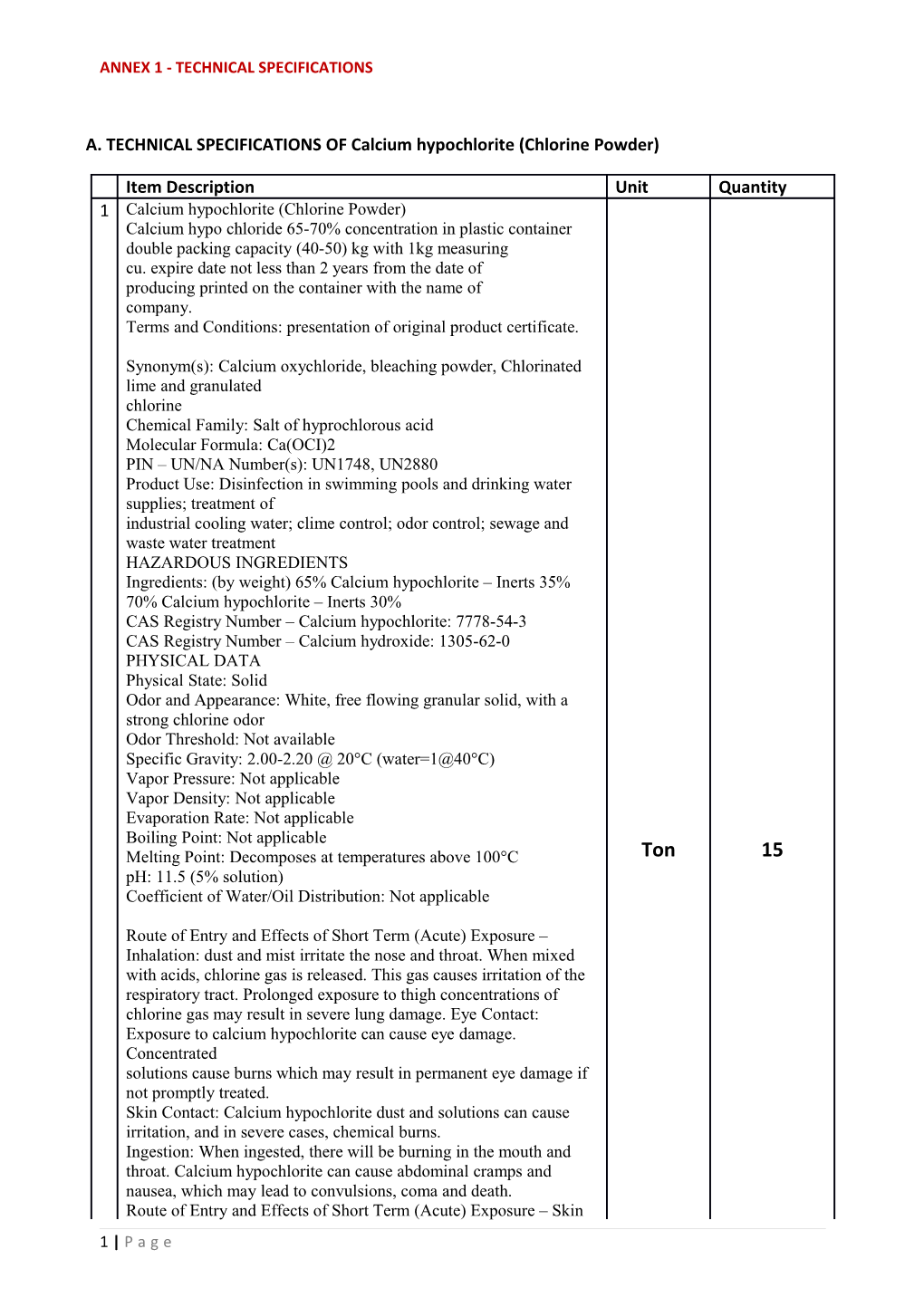ANNEX 1 -TECHNICAL SPECIFICATIONS
A. TECHNICAL SPECIFICATIONS OF Calcium hypochlorite (Chlorine Powder)
Item Description / Unit / Quantity1 / Calcium hypochlorite (Chlorine Powder)
Calcium hypo chloride 65-70% concentration in plastic container
double packing capacity (40-50) kg with 1kg measuring
cu. expire date not less than 2 years from the date of
producing printed on the container with the name of
company.
Terms and Conditions: presentation of original product certificate.
Synonym(s): Calcium oxychloride, bleaching powder, Chlorinated lime and granulated
chlorine
Chemical Family: Salt of hyprochlorous acid
Molecular Formula: Ca(OCI)2
PIN – UN/NA Number(s): UN1748, UN2880
Product Use: Disinfection in swimming pools and drinking water supplies; treatment of
industrial cooling water; clime control; odor control; sewage and waste water treatment
HAZARDOUS INGREDIENTS
Ingredients: (by weight) 65% Calcium hypochlorite – Inerts 35%
70% Calcium hypochlorite – Inerts 30%
CAS Registry Number – Calcium hypochlorite: 7778-54-3
CAS Registry Number – Calcium hydroxide: 1305-62-0
PHYSICAL DATA
Physical State: Solid
Odor and Appearance: White, free flowing granular solid, with a strong chlorine odor
Odor Threshold: Not available
Specific Gravity: 2.00-2.20 @ 20°C (water=1@40°C)
Vapor Pressure: Not applicable
Vapor Density: Not applicable
Evaporation Rate: Not applicable
Boiling Point: Not applicable
Melting Point: Decomposes at temperatures above 100°C
pH: 11.5 (5% solution)
Coefficient of Water/Oil Distribution: Not applicable
Route of Entry and Effects of Short Term (Acute) Exposure –
Inhalation: dust and mist irritate the nose and throat. When mixed with acids, chlorine gas is released. This gas causes irritation of the respiratory tract. Prolonged exposure to thigh concentrations of chlorine gas may result in severe lung damage. Eye Contact: Exposure to calcium hypochlorite can cause eye damage. Concentrated
solutions cause burns which may result in permanent eye damage if not promptly treated.
Skin Contact: Calcium hypochlorite dust and solutions can cause irritation, and in severe cases, chemical burns.
Ingestion: When ingested, there will be burning in the mouth and throat. Calcium hypochlorite can cause abdominal cramps and nausea, which may lead to convulsions, coma and death.
Route of Entry and Effects of Short Term (Acute) Exposure – Skin irritation may occur from repeated or prolonged skin contact.
Exposure Limits –
Time Weighted Average (TLV-RWA): Not available
Irritancy: Not available
Sensitization of Product: Not available
Animal Toxicity Data –
AC50: (Inhalation, rats) – 148 mg/l
LD50: (Oral, rats) – 1300 mg/kg
Carcinogenicity: Not carcinogenic (IARC and ACGIH)
Reproductive Toxicity: Not available
Name of Toxicologically Synergistic Products: Not available. / Ton / 15
Calcium Hypochlorite 65% - 70% Molecular Formula: Ca(OCI)2:
Appearance / White or light-grey granular
Available chlorine / 70%min
Moisture / 5.5-10%
Insolubility / 3.0 %max
Density g/ml / 1.0-1.1
CaCO3 / 3%max
Ca(OH)2 / 2%max
CaCL2 / 2%max
PH (5% SOLUTION) / 12-Nov
MgCL2 / 0.01%max
Fe2O3 / 0.001%max
Al2o3 / 0.0001%max
For 1ppm / For 1000lt Use 1.5-1.7g
Appearance / White or light-grey granular
B. Remarks and Conditions
1 / Standard of products should be compliant with (Turkish and European) standards, with good quality, all the product should be received and checked by related engineers for approval.And product must be succeeded in one of Kurdistan university lab'
2 / All items should be Delivered to directorate of water Duhok warehouse in Etit
1 | Page
